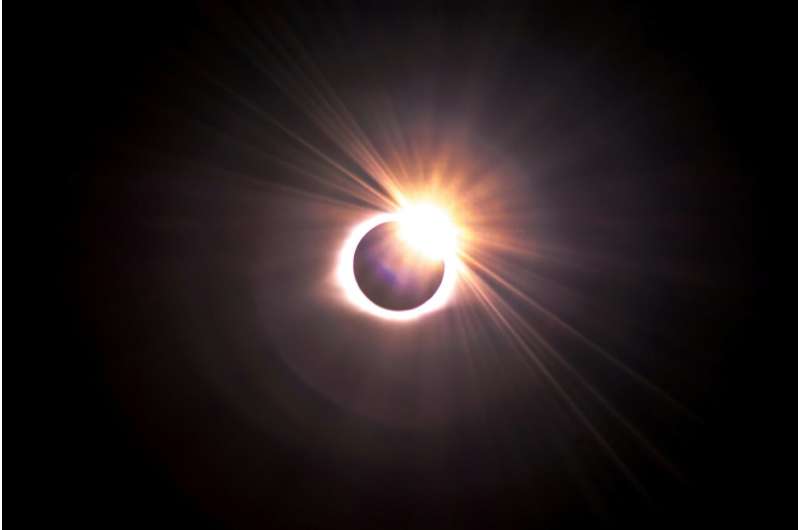This article has been reviewed according to Science X's editorial process and policies. Editors have highlighted the following attributes while ensuring the content's credibility:
fact-checked
reputable news agency
proofread
During the 2024 solar eclipse, Texans will aid a national research effort to study the sun

On a sunny February day at Dallas' Frontiers of Flight Museum, a cluster of students lifted telescope equipment out of a bulky briefcase. A sticker on the case read: "stand back—we're going to science!"
Using a compass and a spool of green thread for alignment, the students fastened their telescope on top of a tripod with the sun framed in view.
On April 8, they'll set up the telescope again, this time on a riverbank 140 miles south of Dallas. They'll be capturing images of the total solar eclipse, when the moon will appear to completely block the sun, causing a brief period of darkness called totality.
Their work will contribute to a national research project called the Citizen Continental-America Telescopic Eclipse 2024 experiment, or CATE 2024. Led by the Southwest Research Institute the project will task crews of volunteers with handling 35 telescopes along the U.S. path of totality, with four in North Texas.
Citizen science efforts like this one will take place across the country during the eclipse, and are designed to bring scientific research out of the ivory tower.
"An understanding of science is good for everybody," said Amir Caspi, an astrophysicist at the Southwest Research Institute who is leading this year's project. "Breaking down that disconnect between scientists and everybody else is really important."
Studying the sun
The Citizen CATE project aims to broaden scientists' understanding of the star that guides our existence on Earth.
"The sun is basically the reason that everything's alive," Caspi said. "But it's also the reason that everything could be dead."
The sun has a complex magnetic field that can get stressed or tangled, leading to solar flares and storms that may disrupt power grids, obscure GPS signals and cause satellites to go offline.
To predict these solar events, researchers want to gain a better understanding of the sun's magnetic field. One way they do so is by studying the corona, the sun's hot outer atmosphere where charged electrons bounce along magnetic field lines.
A total solar eclipse offers a rare opportunity to glimpse the corona with the naked eye during totality. The corona can get as hot as 2 million degrees Fahrenheit, but it's not as bright as the surface of the sun, which we see during the day.
This year's CATE project evolves the original 2017 experiment by measuring polarization: the direction that sunlight waves "wave" as they scatter in the corona. Analyzing polarization data can help scientists learn about the corona's 3D structure.
"Hopefully, we'll be able to watch the sun's corona change," said Pat Reiff, an astronomy professor at Rice University who is overseeing several Texas CATE teams.
Breaking barriers to science
The North Texas CATE teams are a mix of students, teachers, community members and retirees. Learners young and old will work together to capture the sun's corona at four sites along the eclipse's path.
Jo Lin Gowing, a mechanical engineering professor at LeTourneau University, found out about the project from a university chat server. She saw a solar eclipse in college and thought the CATE project would be a great way for her students to learn and interact with the broader scientific community.
"People need to know what's going on in the world around them," she said.
The CATE project is one of many citizen science projects getting communities involved with eclipse research.
Students and faculty at Western Kentucky University have designed an app called SunSketcher that will allow users to take images of the eclipse that will be used to measure the shape of the sun. Eclipse Megamovie, organized by researchers from Sonoma State University and UC Berkeley, is soliciting eclipse images to study the movements of hot plasma bursts called solar jets.
Such projects give anyone the opportunity to be a scientist without needing to buy expensive equipment. The telescope, camera and hardware each CATE team will use to collect the data cost about $8,000.
After the eclipse, the telescopes will stay with local communities to let the learning continue. The CATE project will disseminate educational plans so that learners at Kemp High School, LeTourneau University and the Frontiers of Flight Museum can use the equipment to look at stars and planets.
Parker Jones, a junior at Kemp High School, heard about the CATE project from her robotics teacher. Her team's telescope site is in a field south of Dallas near a cemetery and a peach farm.
On April 8, they'll need to build it without in-person help from the CATE organizers—all while hoping clouds don't cover the sun entirely.
"It seems like it would be stressful in the moment, having to get it right," she said, "and knowing that other people will be looking forward to what you produce."
Jones has always loved space and is looking forward to collecting data on eclipse day. She's excited to witness a celestial event not just as a student, but as a scientist.
2024 The Dallas Morning News. Distributed by Tribune Content Agency, LLC.





















